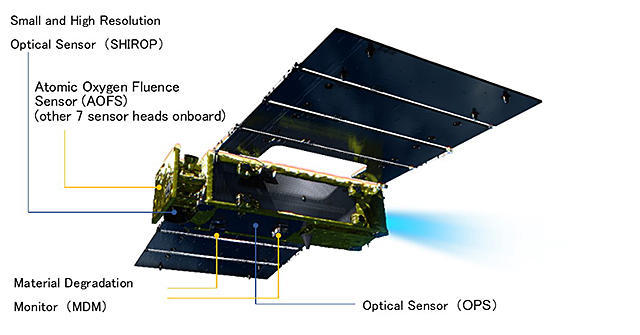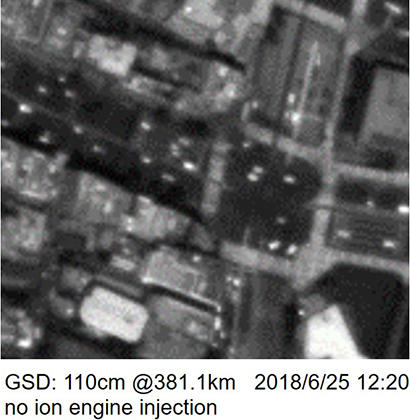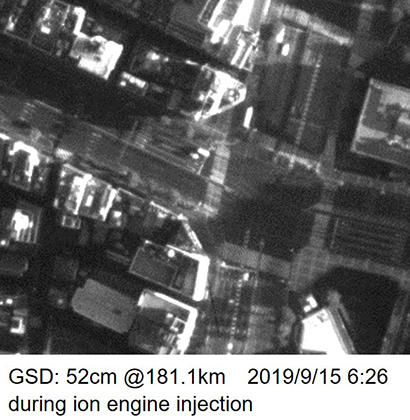JAXA terminates the operation of TSUBAME, a Super Low Altitude Test Satellite (SLATS)
October 2, 2019 (JST)
National Research & Development Agency
Japan Aerospace Exploration Agency (JAXA)
Japan Aerospace Exploration Agency (JAXA) successfully completed the orbit keeping operations of the Super Low Altitude Test Satellite (SLATS) “TSUBAME”*1—which was launched on December 23, 2017—at 9:42 (JST, Japan standard time) on September 30, 2019 and shut down the transmission to and power source of the satellite entirely at 19:13 (JST) the following day, on October 1.
The greatest advantage of super-low Earth orbit satellites like TSUBAME is their ability to capture high-resolution satellite image data using a small sensor. However, because at super-low altitudes between 200 and 300 kilometers, atmospheric drag and the density of atomic oxygen, which causes satellite materials to deteriorate, are approximately 1,000 times greater than that of altitudes at which most of Earth observation satellites are operated, the super-low altitudes were considered unsuitable for Earth observation satellites, which require precise control of the attitude and orbit and long-time operations.
Powered by an ion engine, which is low in thrust but high in propulsive efficiency, TSUBAME demonstrated its capability to maintain six different orbital altitudes*2 between 271. 1 and 181.1 kilometers and successfully completed the experiment of capturing high-resolution, high-quality satellite image data*3. TSUBAME also provided unprecedentedly long-period data, such as those concerning the density of atmosphere and atomic oxygen and the deterioration of material samples exposed to the atmosphere, and proved that the materials developed by JAXA can withstand the long-time exposure to atomic oxygen.
JAXA thus was able to acquire technology and knowhow regarding Earth observations from super-low altitudes and effect of atomic oxygen, by the orbit maintaining operations with the ion engine, for the first time in the world. Moving forward, JAXA will translate the knowledge obtained through the TSUBAME project into future space utilization and contribute to promoting technological and scientific development and solving social issues.
JAXA expresses its deepest gratitude to all the organizations and individuals who cooperated in and supported the development and operation of TSUBAME.
| *1: | Please visit http://www.satnavi.jaxa.jp/project/slats/ for more details on the satellite. |
|---|---|
| *2: | Orbital altitude = Semi-major axis of the satellite's orbit - Equatorial radius. |
| *3: | Please visit http://www.satnavi.jaxa.jp/project/slats/captured/ for the captured images. |
【Illustration of Tsubame in orbit】

【Result of SLATS Orbital Profile】

(1) Small and High Resolution Optical Sensor (SHIROP)
19.4 kg and 20 cm in effective aperture diameter, the SHIROP is a small optical sensor developed for the purpose of verifying the technology for capturing images with a resolution of one meter or less from super-low altitudes. Although the SHIROP is smaller in diameter than the Panchromatic Remote-sensing Instrument for Stereo Mapping (PRISM)—30 cm in effective aperture diameter and 2.5 meters in resolution—onboard the Advanced Land Observing Satellite (ALOS) “DAICHI,” launched on January 24, 2006, the SHIROP is capable of providing 0.5-meter level resolution imagery through super-low altitude observations.


The two images shown below are examples of how the resolution can be improved at a lower altitude. The both are images of the area around the Yotsuya Mitsuke intersection in Tokyo, but while the left image was captured on June 25, 2018, from the altitude of 381 kilometers, the right image was captured on September 15, 2019, from the altitude of 181.1 kilometers. The 200-kilometer difference resulted in the difference in resolution—1.1 meters in the left image and 0.52 meter in the right image—showing pedestrian crossings, driving lanes, and cars more clearly in the right image. There is also no sign of deterioration in the right image caused by increased atmospheric resistance or ion engine blast, and it is confirmed that high-quality images can be captured even at super-low altitudes.
(2) Atomic Oxygen Monitoring System (AMO)
Atomic oxygen, a main component of the atmosphere at super-low altitudes of 200 to 300 kilometers, is highly reactive and known to cause damage to golden thermal control films used to cover the surfaces of satellites. In the TSUBAME project, the AMO was used to measure the density of atomic oxygen and observe how the substance can cause deterioration to satellite material samples.
It was the world’s first attempt to measure the density of atomic oxygen and monitor the deterioration of materials exposed to the atmosphere at an altitude lower than 300 kilometers and over the long period of six months. These data acquired from the TSUBAME project will be utilized to improve the precision level of atmospheric models currently used and elucidate physical phenomena associated with the upper atmosphere and the ionosphere. The knowledge in the area of atomic oxygen, which JAXA obtained ahead of anyone else in the world, is expected to provide basis for the development of Japan’s first satellite design guidelines and the creation of Japan’s unique, new materials.